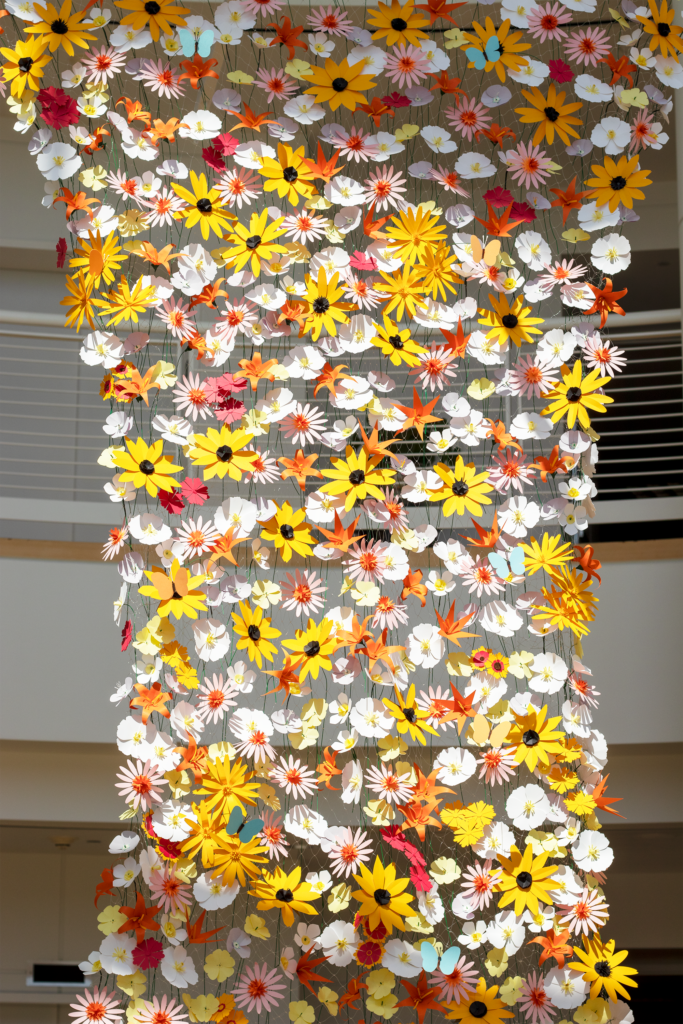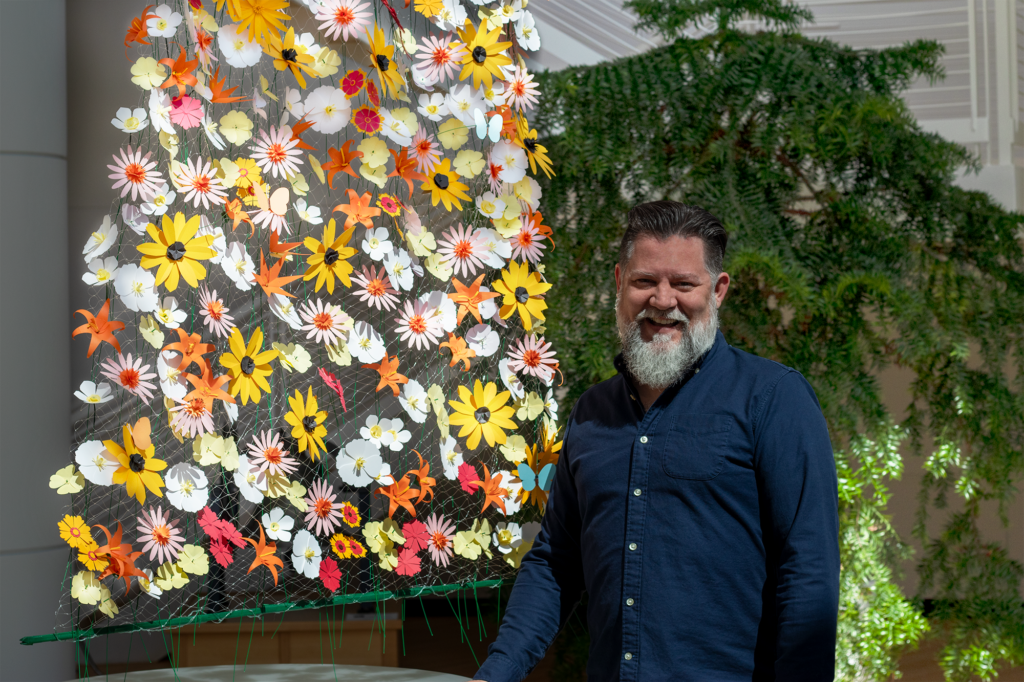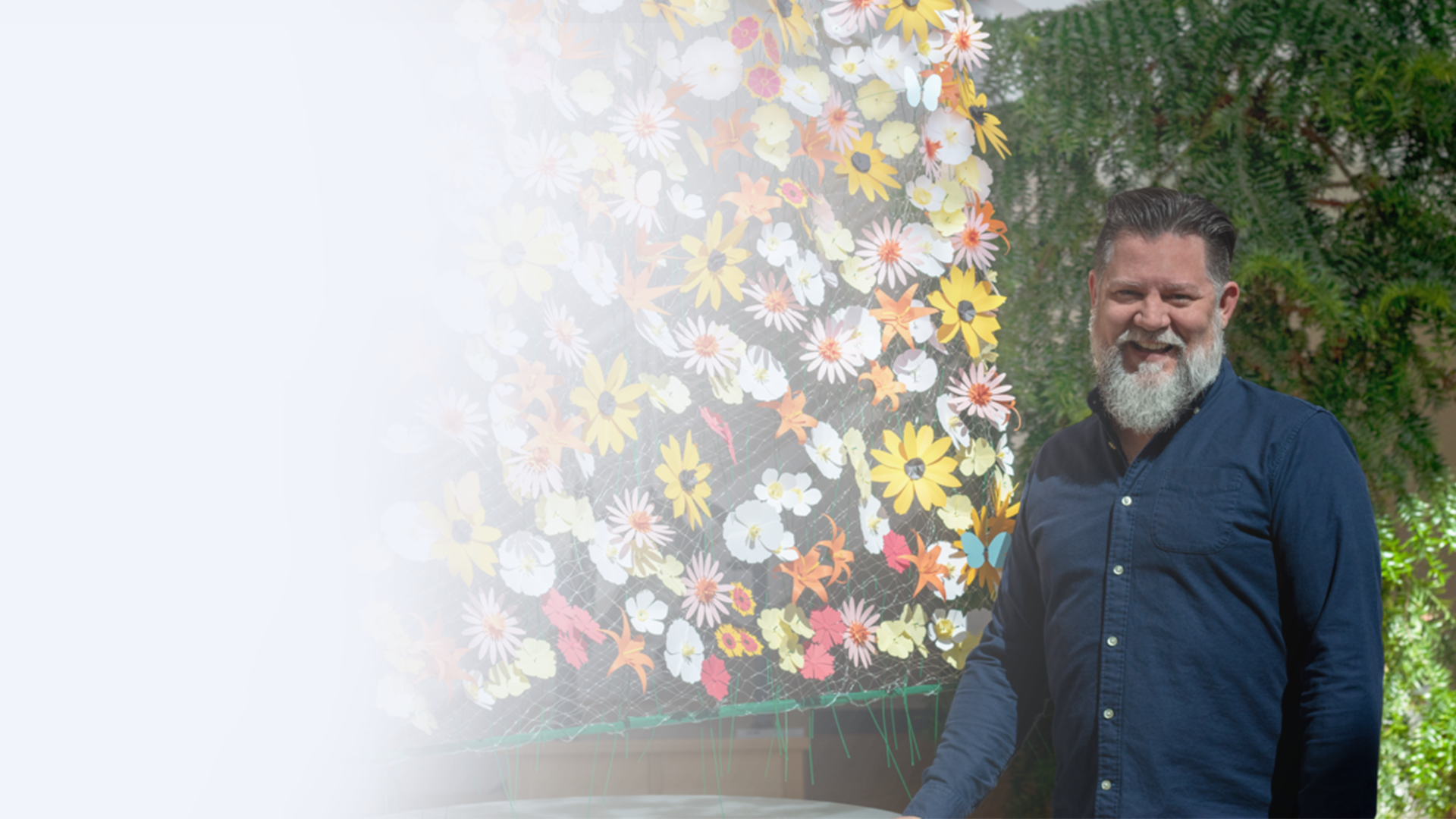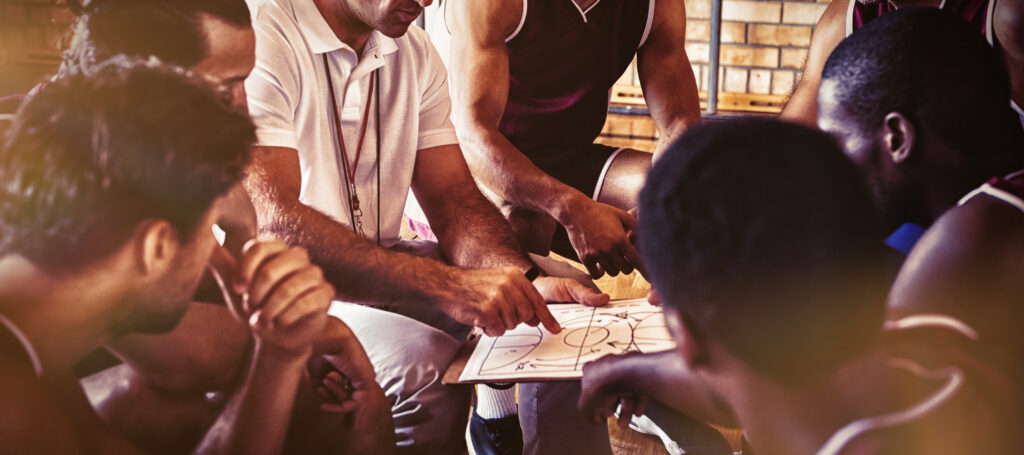It’s a great day at Talent Plus. You’ve likely heard this warm welcome if you’ve called Talent Plus corporate office, and more likely than not it was the voice of Michael Trutna, Talent Plus First Impressions Lead, who greeted you. He ensures daily that each and every person, whether over the phone or on an in-person visit to our Lincoln Office, has a red-carpet experience. But he doesn’t stop here.
Currently gracing the 40-foot-high atrium of Talent Plus’ headquarters is FlowerFall, an art installation ideated and created by Michael himself. He spent 250+ hours designing and hand-building each paper flower with extreme attention to detail and about 25 hours assembling the piece. His spring-inspired art has added new life and beauty to the gallery-like entrance space.
We sat down with Michael to get the full story. Welcome to our first Talent Plus Spotlight on Colleagues.
Q: Where did the idea for your piece, FlowerFall, come from? Can you talk about your inspiration?
A: I have always felt the atrium would be a great space to utilize for large-scale art projects or art works on a continuing basis. We had just started to conceptualize the mechanics of a connection with artists in Lincoln, to find artists whose work would be a good match for the space; those efforts were placed on hold due to COVID-19. I felt that, since we had quieter time in the office, I could attempt a dry run for an atrium installation.
Then, the decision was made not to put up our usual holiday décor in the atrium. I had mentioned that I would like to create a hanging holiday decoration in the space, and I was given the go-ahead to proceed with decorating the space. Recycling the holiday decorations previously used for our atrium tree, I suspended a series of oversized pieces in a triangle configuration in the shape of tree, with a three-dimensional multi-pointed Moravian star at the top and a squared piece at the bottom to infer the trunk.
Mounting the decorations required some specific measurements to establish the shape, but it went up relatively fast and easy. I received a great deal of colleague encouragement during preparation and compliments once it was complete. It was a good project to boost my confidence and propel me into doing something a bit more challenging.
I had been thinking about something to do in the spring. I had found a few artists who have done some interesting things with cut flowers. One in particular – Rebecca Louise Law – does amazing large-scale installations, often working only with flowers and thin copper wire.
It looks as if the flowers are suspended in midair. It’s a stunning effect, and it sent me in a direction of working not with cut flowers, but with paper flowers instead. I wanted to highlight a variety of flowers that were native to the areas found in the state: the grasslands, the Nebraska sandhills and the wooded areas surrounding the Missouri river valley. I researched native and nonnative varieties to find an eclectic combination of flowers.
Q: How did you create and make the flowers?
A: The flowers are made from my own patterns – each flower is my interpretation of the blooms. I wanted detail in each flower, but I chose not to attempt a literal realism, since I knew that the cardstock paper used for most of the blooms wouldn’t allow for the realism that can be achieved by using crepe paper, which behaves most similarly to the delicate texture of most petals in nature.
The first flowers I created were cut entirely by hand – around two hundred or so blooms. Every flower is assembled, and most of the petal pieces are fashioned from stacking two or three patterns on top of each other to achieve a layered effect – none of the petal pieces are from a single piece.

The FlowerFall sits 40 feet high.
Q: Why did you choose paper as your medium?
A: I’ve always found paper to be very versatile, and I’ve always been drawn to things made with paper. I also like that paper is a relatively perishable medium. The considerable amount of leftover paper scrap material from the construction process can be easily discarded and also will decompose. If the blooms were made of an acrylic or a plastic, the process of disposing of the leftover material would be very different.
Q: Aside from learning to make the flowers, what else did this whole process teach you?
A: One of the things that I had experienced was the need for flexibility. I had a target weekend planned for the installation, but I had to modify the timeline. I moved the installation back a week – we had several colleagues who planned to be in the office that weekend, and I didn’t want the clutter of my materials to be in their way.
Q: How did you decide on the design structure that holds the flowers?
A: I wanted the flowers to have the appearance of flow, of being funneled or channeled, like a waterfall. I then looked for a material that could provide the sturdy support and also refrain from drawing attention to itself. I found an acrylic backing – a netting that was malleable, yet strong – that I could trim and fold to achieve the shape. I wasn’t sure what the degree of stretch would be in the acrylic material, so the ultimate size of the finished piece was unknown until the installation process was underway.

Michael Trutna, Talent Plus First Impressions Lead, stands next to his creation, FlowerFall
Q: How do you feel your art installation and future ones will affect the overall experience for colleagues and guests as they enter our building?
A: I like the idea of having something in the atrium that people can experience. Something that draws people to the space to gather and linger, rather than merely being an area that’s passed through. I hope to draw more people to the atrium, through return-to-the-office events, or morning or afternoon coffee breaks, to encourage more socializing in the space.
Q: You previously mentioned how working on this piece really helped to boost your morale. I’m curious how that came to be for you? Also, how would you encourage other people at work to do something beyond their role?
A: The first piece I did – the simpler holiday installation – was a confidence booster. It provided motivation, allowed me to say, ‘yes, I can,’ and propelled me into the next project I wanted to tackle, which was a little more complicated.
I think it’s important to have that special spark of interest which draws you to that new adventure, that new activity, that new task, that new hobby. When that spark is present, though the task or activity might feel somewhat daunting, I think it’s such a great energy to draw from. That spark can make you challenge yourself to take that step, that leap, and try that new thing.
On a personal note, I find that I always need to focus on my list. Once I conceptualize a larger project into a series of tasks or action items, nothing will overwhelm me – neither the planned items nor the unexpected elements.
In my personal experience, whether it’s rehearsing with an orchestra or reorchestrating a piece of music for a show, or rehearsing with the quartet that I sing with, all the tasks that could seem daunting are far less so when you stay to a list of action items. Checkable items. Also, the checking off is such a great feeling – it’s always such a weight off one’s shoulders.
Talent Plus
Talent Plus is a team of industry experts who collaborate to deliver insightful and impactful content. Our blogs are designed to provide practical advice and fresh perspectives, helping you stay informed and ahead of the curve.








